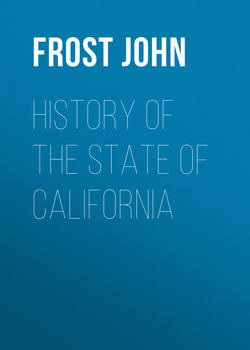Читать книгу History of the State of California - Frost John - Страница 5
CHAPTER IV
ОглавлениеFROM THE REVOLUTION TILL THE WAR BETWEEN THE UNITED STATES AND MEXICO
Before the commencement of the struggle for independence in Mexico, the missions in California were, to some extent, fostered by the Spanish government, and supplies were sent to them regularly. But when the war began, the remittances were reduced, and the establishments soon began to decay. After the overthrow of the Spanish rule, in 1822, the territory of California was divided into two portions. The peninsula was then called Lower California, and the whole of the continental territory called Upper California. When the Mexicans adopted a constitution, in 1824, each of these territories became entitled to send one representative to the National Congress. At the same time, the adult Indians who could be considered civilized, were declared citizens of the republic, and had lands given to them. This, of course, freed them from submission to the missionaries, who, thus deprived of their authority, either returned to Spain or Mexico, or took refuge in other lands. The Indians being free from restraint, soon sank to a low depth of barbarism and vice.
Immediately after the overthrow of the Spanish authorities, the ports of California began to be the resort of foreigners, principally whalers and traders from the United States. The trade in which they engaged, that of exchanging manufactured goods for the provisions, hide and tallow furnished by the natives, was at first irregular, but as it increased, it became more systematic, and mercantile houses were established in the principal ports. The Mexican government became dissatisfied with this state of things, and ordered the governor of Upper California to enforce the laws which prohibited foreigners from entering or residing in the territories of Mexico without a special permission from the authorities. Accordingly, in 1828, a number of American citizens were seized at San Diego, and kept in confinement until 1830. In that year, an insurrection broke out, headed by General Solis, and the captured Americans were of some assistance in suppressing it, and, in consideration of their services, they were permitted to leave the territory.
The Mexican government strove to prevent the evils expected to flow from the presence of numbers of foreigners in California, by establishing colonies of their own citizens in the territory. A number of persons were sent out from Mexico, to settle on the lands of the missions, but they never reached their destination. The administration which originated the scheme was overthrown, and the new authorities ordered the settlers to be driven back to Mexico. In 1836, the federal system was abolished by the Mexican government, and a new constitution adopted, which destroyed all state rights, and established a central power. This was strenuously resisted in California. The people rose, and drove the Mexican officers from the country, declaring that they would remain independent until the federal constitution was restored. The general government issued strong proclamations against the Californians, and sent an expedition to re-establish its authority. But General Urrea, by whom the expedition was commanded, declared in favor of the federalists, and the inhabitants governed themselves until July, 1837, when they swore allegiance to the new constitution.
Things went on quietly in California until 1842. In that year, Commodore Jones, while cruising in the Pacific, received information which led him to believe that Mexico had declared war against the United States. He determined to strike a blow at the supposed enemy, and, accordingly, he appeared before Monterey, on the 19th of October, 1842, with the frigate United States and the sloop-of-war Cyane. He demanded the surrender of all the castles, posts, and military places, on penalty, if refused, of the visitation of the horrors of war. The people were astonished. A council decided that no defence could be made, and every thing was surrendered at once to the unexpected Americans. The flag of the United States was hoisted, and the commodore issued a proclamation to the Californians, inviting them to submit to the government of the United States, which would protect them in the exercise of their rights. The proclamation was scarcely issued, before the commodore became aware of the peaceable relations existing between the United States and Mexico, and he accordingly restored the possession of Monterey to the authorities, and retired with his forces to his ships, just twenty-four hours after the surrender. This affair irritated the inhabitants considerably, and, no doubt, tended to increase the ill-feeling before existing between Mexico and the people of the United States.
